
The Permian basin playbook: Optimizing design experimentation Moving the US shale revolution forward
20 minute read
23 October 2019
 Scott Sanderson United States
Scott Sanderson United States Andrew Slaughter United States
Andrew Slaughter United States Anshu Mittal India
Anshu Mittal India Vivek Bansal United States
Vivek Bansal United States
Even after almost 100 years, the Permian continues to grow from strength to strength. However, flattening gains indicate that operators must adopt strategies that combine their technical know-how with analytical capabilities.
Executive summary
It’s been almost a century since the Permian basin started producing oil from conventional resources. And while much has changed, the basin is growing from strength to strength due to the shale revolution. From being a key basin in the United States, its potential and current output is now comparable to some of the largest oil producers in the world—with a total resource potential of 46 billion bbl of oil, the current production of the Permian basin is only behind that of five countries.1
Learn more
Explore the collection
Read more in Oil, Gas & Chemicals
Download the Deloitte Insights and Dow Jones app
Subscribe to receive more content from Deloitte Insights
Undoubtedly, the Permian is a gold mine. But debates about enhancing well performance—and the economics of it—continue unabated. Given the erratic behavior of shales, companies have been unable to define a performance ceiling. Further, most players in the basin are still in the experimentation phase and trying to test traditional operational strategies, while much has changed otherwise.
Perhaps it’s time for companies, analysts, and even investors to renew their understanding about the basin through a blend of technical and analytical aspects. This new understanding could not only assist in unearthing potential opportunities but also help simplify the complexity and tap into those opportunities. In this paper, we attempted one such assessment, using the operational data of 18,000 wells drilled in the Permian basin over the past decade.
Our four-part article series, Moving the US shale revolution forward, aims to study the learning curves, unearth success factors, and identify operational well-enhancement opportunities for US shale operators. The analysis is based on Deloitte’s statistical interpretation of reported well-level geological, engineering, and productivity data.
The analysis focuses on aggregate performance indicators across the plays. It is intended to complement, not replace, companies’ sophisticated geological and field planning models of their own operations. The opportunities highlighted in these articles are at a well level, as against at the overall field/portfolio level. Given the heterogeneity of shale geology, operators could use this analysis to identify specific factors to explore in their own proprietary drilling, completion, and operations data.
Key highlights
- Formation matters, but how much? Superior formation quality is a notable value-add but not the sole performance differentiator in the basin—45 percent of wells in Tier 1 zone had a well productivity <1,000 boed per 10,000 feet perforated interval.
- No straight answers: A better combination of formation type and engineering design seems to explain the Permian’s superior performance, but shale’s nonlinear response to completion parameters makes it challenging to pinpoint answers.
- Finding middle ground: Optimal operating points to realize productivity with least intensity are quite different across zones in the Permian. Intense fluid and proppant loading with shorter laterals seem to be working in the Delaware basin, while longer laterals with lower intensity seem to work better in the Midland basin.
- Getting the equation right: Many players have struggled to optimize the formation-engineering equation in the Permian—in the past 3–4 years, 67 percent of wells ended up with either over- or under-engineered designs.
- Scope for tangible cost savings: Although a proportional change in productivity at times makes up for unoptimized designs, a balanced formation and engineering equation could have improved the capital efficiency (EUR/DC&E cost) of Permian operators by 23 percent.
Overview of the Permian basin
Spread over an area of 75,000 sq. miles, the Permian Basin lies across West Texas and Southeast New Mexico, where cities and towns seem forever changed, thanks to the regional shale activity. The Permian holds recoverable reserves of 46 billion bbls of oil, 281 tcf of natural gas, and 20 billion bbls of natural gas liquids. In 2018, the United States Geological Survey revised this number upward, effectively increasing total US crude oil reserves by 100 percent and natural gas reserves by 65 percent.2
The Permian’s two major sub-basins—Delaware and Midland—and the Central Basin Platform that rises between them, together drive its capacity as America’s largest crude oil–producing basin and shale oil reserve (see figure 1). While the Spraberry formation of Midland and Bone Spring formation of Delaware are where the first drilling activities of this basin commenced, the stacked Wolfcamp formation, which underlies all three (with a thickness between 200 ft and 7,050 ft.), is where recent potential has been identified. Several stacked formations make up these sub-basins, with varying proportions of sandstone, organic rich shale, and siltstone across each sub-basin as well as play.3
The rich recoverable resources, coupled with several pipeline projects underway in proximity to the Gulf of Mexico and Texan refineries, could translate into considerable potential for the Permian in the years to come.
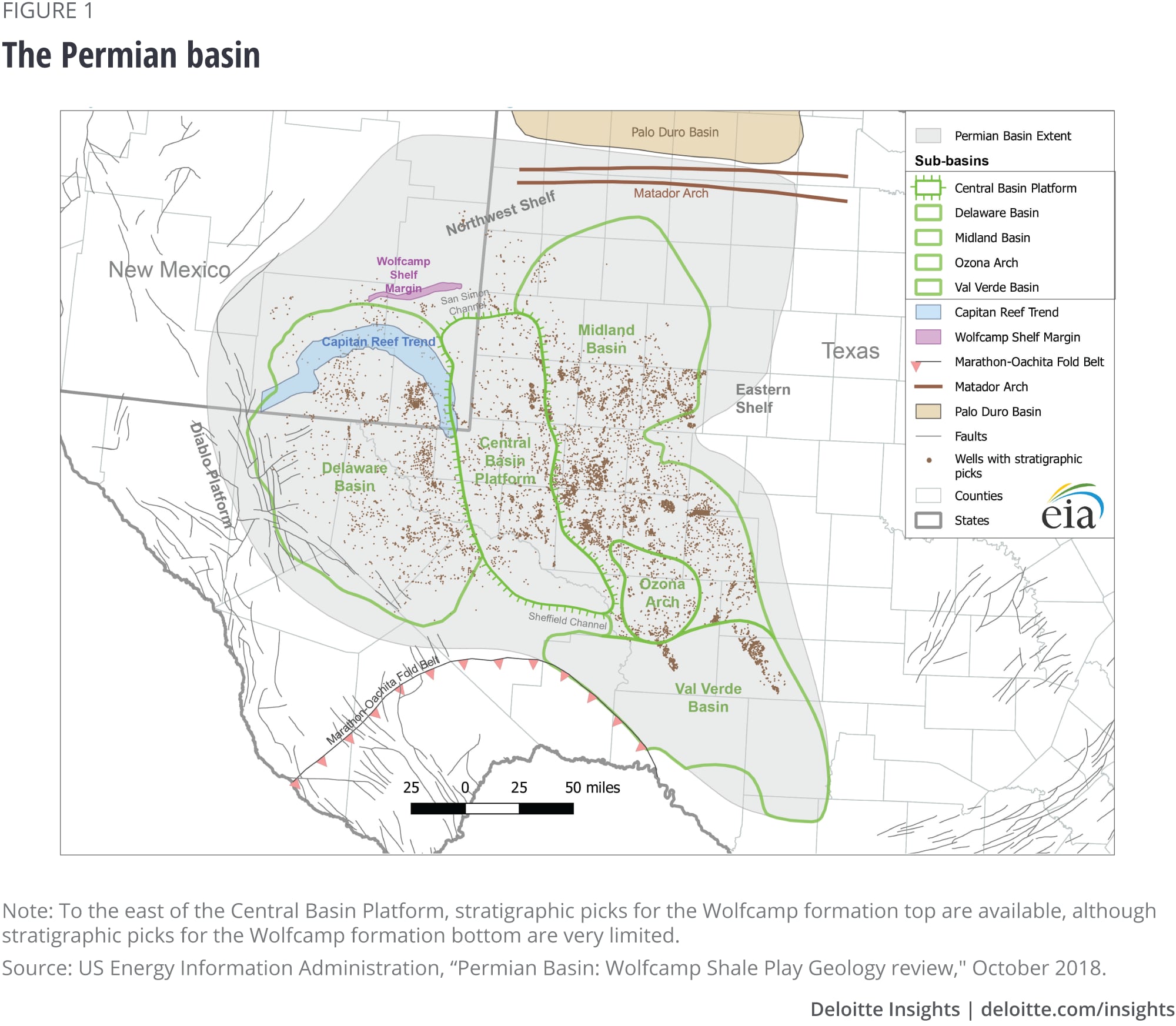
Permian: Never failed to surprise
The Permian basin, which was in the decline phase from the 1970s to the 2000s, has created a remarkable impact on the US shale industry by not only thriving during the oil downturn but also enabling growth in the local economy.4 The basin’s O&G production tripled over the past five years (see figure 2), with its current oil production exceeding that of most OPEC members except Saudi Arabia and Iraq. A large part of this transformation is attributable to the dozens of oil-bearing stacked formations that were exploited by companies using a combination of technical innovations and investments to the tune of US$20–25 billion per annum.5 This growth was further enabled by mature regulatory frameworks and an established ecosystem of oil and gas infrastructure in the region.
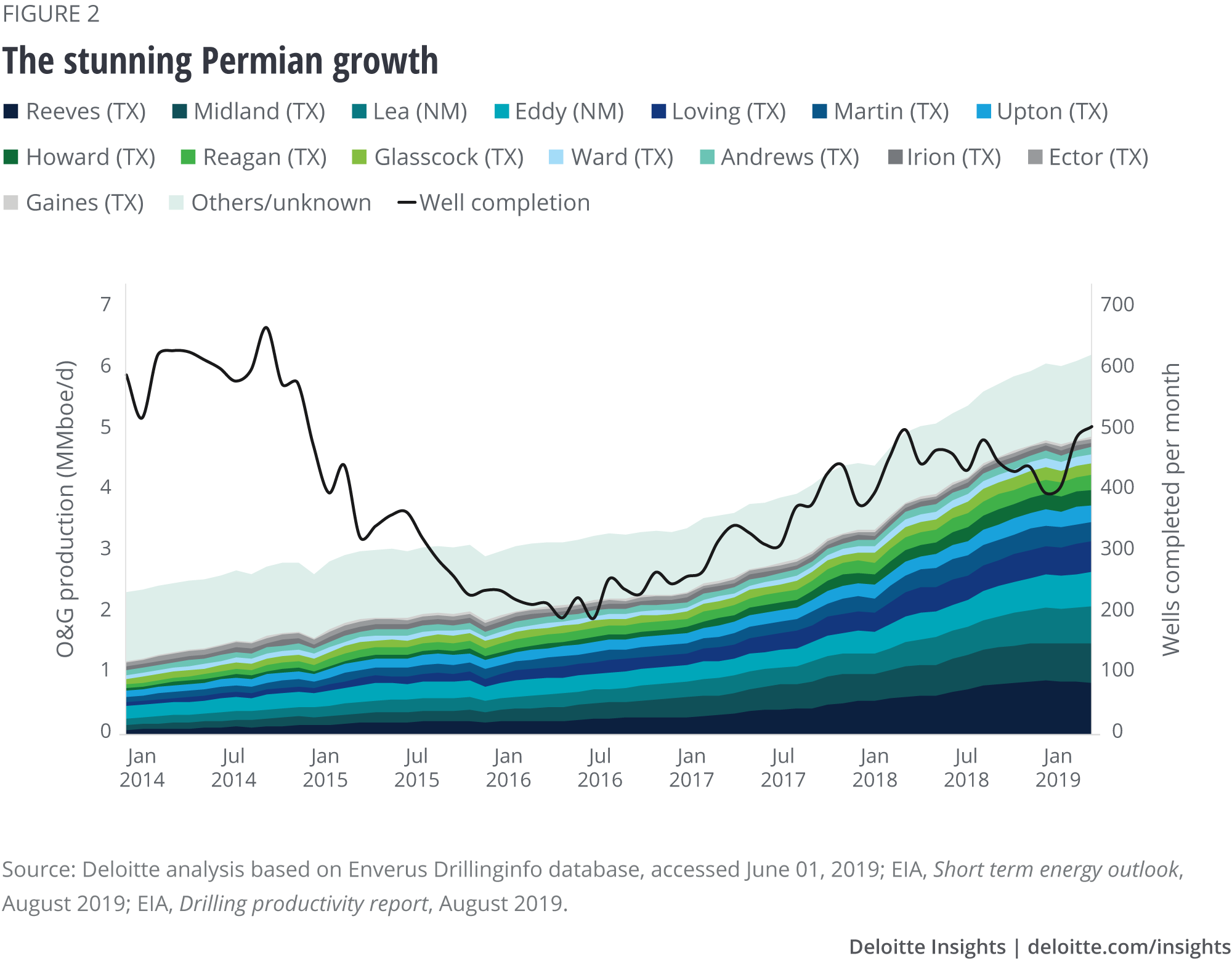
Even after many years of double-digit growth, production in the Permian shows no sign of slowing down. On the contrary, it continues to surprise everyone—the EIA now expects oil output from the Permian to reach 5.4 MMbbl/d by end-2020, a level that many agencies earlier thought achievable only by 2023.6 And the ripple effect of this surge on investments in related subsectors and oil exports will only solidify the position of the Permian in the US energy landscape. Moreover, the degree of consolidation and growing prominence of supermajors in the basin reflect its importance—supermajors such as Exxon Mobil and Chevron have outlined ambitious plans to increase their Permian output to 0.9–1 MMbbl/d by 2023.7
Sustaining the desired production growth via higher completed activity in a favorable price environment is one thing. But doing that with the optimum productivity profile that is resilient to price cycles is another—and this has been the focal point of nearly all industry discussions lately. Many industry analysts have raised questions around the basin’s flattening productivity gains and limited scope to enhance performance. In fact, the lagging stock performance of E&Ps against oil prices (for more details, read Exploration & production: Overcoming barriers to success) may also highlight investors’ worry about future improvements in ROI, which is highly desired to make up for any potential surge in costs and high premiums paid for acquiring acreages.
Although a higher well-completion rate to realize the production growth in the past two years affirms the well-productivity issues to some extent, the complex nature of shale play development demands a much deeper well- and formation-level analysis to understand the potential of future improvements in the basin.
A basin of boundless opportunities
Many believe that the productivity gains realized in the past are mainly a function of high-quality thick-stacked formations in the Permian and that increased activity outside sweet spots should always lead to lower overall productivity. To test this hypothesis, we developed a formation quality score for wells drilled in the basin since 2009 (refer to Deciphering the performance puzzle in shales for details on this) and used those scores to outline the boundaries of high-formation quality zones (Tier 1) in both the Delaware and Midland sub-basins (refer to the appendix for more details). Overlaying these formation area maps with the performance data (initial 180-day production normalized to 10,000 feet perforated interval) revealed some interesting results.
Surprisingly, formation quality has not influenced well performance to the extent that is usually anticipated (see figure 3). A comparable number of high-performing wells (>1,000 boed) exist in both the zones of Delaware—55 percent in Tier 1 versus 41 percent in Tier 2/3.8 In fact, some wells operated by Matador Resources in 2018 in the northernmost part of Eddy, which is far outside the Tier 1 zone, registered a normalized IP rate of 2,500 boed, which is superior to 90 percent of the wells in the Tier 1 zone of Delaware.9 Similarly, the share of wells that struggled to deliver the desired productivity results (represented by red dots in figure 3) was quite high in both zones of Midland.

Further, experiential and technological improvements in recent years seem to have helped operators irrespective of their acreages. In fact, the performance divergence by formation quality further faded away in Delaware during the past 2–3 years and operators have struggled to deliver consistent performance even in the same formations. For instance, in 2018, a leading independent player drilled two wells in the sweetest spot of Loving County, targeting the Wolfcamp-A Lower formation. One of those two wells delivered productivity in the range of 2,300 boed, while the other one could merely reach 450 boed.10
So, challenges even in the best zones, combined with exceptional results by some in Tier 2/3 areas, indicate that activity in unfavorable zones can’t be blamed for flattening overall gains. Although a high share of low-productive wells across the basin affirms the concerns raised by the markets, we believe it reflects the scope and quantum of opportunity that is still accessible to improve and enhance well performance. Just imagine the gains in the Permian if operators are somehow able to decimate the share of nonproductive wells. And knowing that it is even possible in Tier 2/3 zones, it further expands the boundary of opportunities available to small and mid-sized players that hold sizeable positions in such areas.
With formation being a key value-add, and not a sole performance differentiator in the Permian, companies could explore working on their engineering and design strategies to further elevate their well performance. This is a node that is very much in the control of operators and could guide the desired improvements by self- as well as peer learning. For instance, one of the supermajors gave equal importance to the rock quality and the designs and hence was able to realize higher productivity irrespective of acreage quality—1,380 boed in Tier 2/3 and 1,210 boed in Tier 1 formation of the Delaware basin.11
What happens when conventional techniques fail?
The most relevant advances made during the past few years in US shales are around completion design enhancements, and operators continue to experiment with that. However, the nonlinear nature of shales makes it difficult for most players to zero in on the optimal design parameters that may or may not work in shales. Too often, players tend to rely on conventional rules of thumb to make design predictions based on recent learnings and end up with a notable inventory of unoptimized wells. For instance, there is a widespread acceptance of the fact that a well’s poor performance is largely attributable to its lower design intensity.
However, a divergent range of design parameters for nonproductive wells in the Delaware and Midland basins indicates it is nearly impossible to narrow down possibilities and document design combinations that lead to superior or inferior well performance (see figure 4). In Midland’s Regan county, for example, 592 wells underperformed with practically all the possible design combinations—from highly intense completions ranging from 4,000 to 10,000 feet perforated intervals to low-to-moderately intense completions from 2,000 to 15,000 feet perforated intervals.12 The story is quite similar at an operator level as some leading independents have completion intensity variation in the range of 400–500 percent for their nonperforming wells in the Delaware basin.13

We tested whether this divergence is due to experimentation by various operators to find their best range during their early years of operation in the Permian. However, that is not the case, as nearly one-third of the underperforming wells with diverse design ranges were drilled in the past three years. In fact, the variance in the volume of proppants and fluids pumped per feet in each sub-basin has increased dramatically in the past few years—the standard deviation of proppant and fluid loading data in the Permian increased by 2.5x to 5x in the past 10 years, reflecting that experimentation is on the rise.14
So, a noncollinear response of Permian’s formation to completion parameters continues to challenge conventional techniques of operators. Deeper analytical perspectives about the most optimal designs could help realize full reservoir potential.
A three-step approach for operating optimally in the Permian
To optimize well designs, and hence the productivity in the Permian, companies might have to complement their sophisticated technical models with comprehensive analytical perspectives. The idea here is to go beyond simple pattern recognitions and draw on unique statistical insights that can help companies make informed decisions on their engineering designs. In this section, we present a three-step statistical technique for companies to consider as they address key challenges to shale development, including inconsistent rock behavior, divergent designs, and unoptimized recovery (see figure 5).
- Step 1: Identify statistical significance of all completion variables in each zone (random forest models)
- Step 2: Discover the optimal design range or combination for each zone (cluster analysis)
- Step 3: Model the variable significance and optimal ranges into well-type curves to identify the best operating point (well-type curves and economic models)
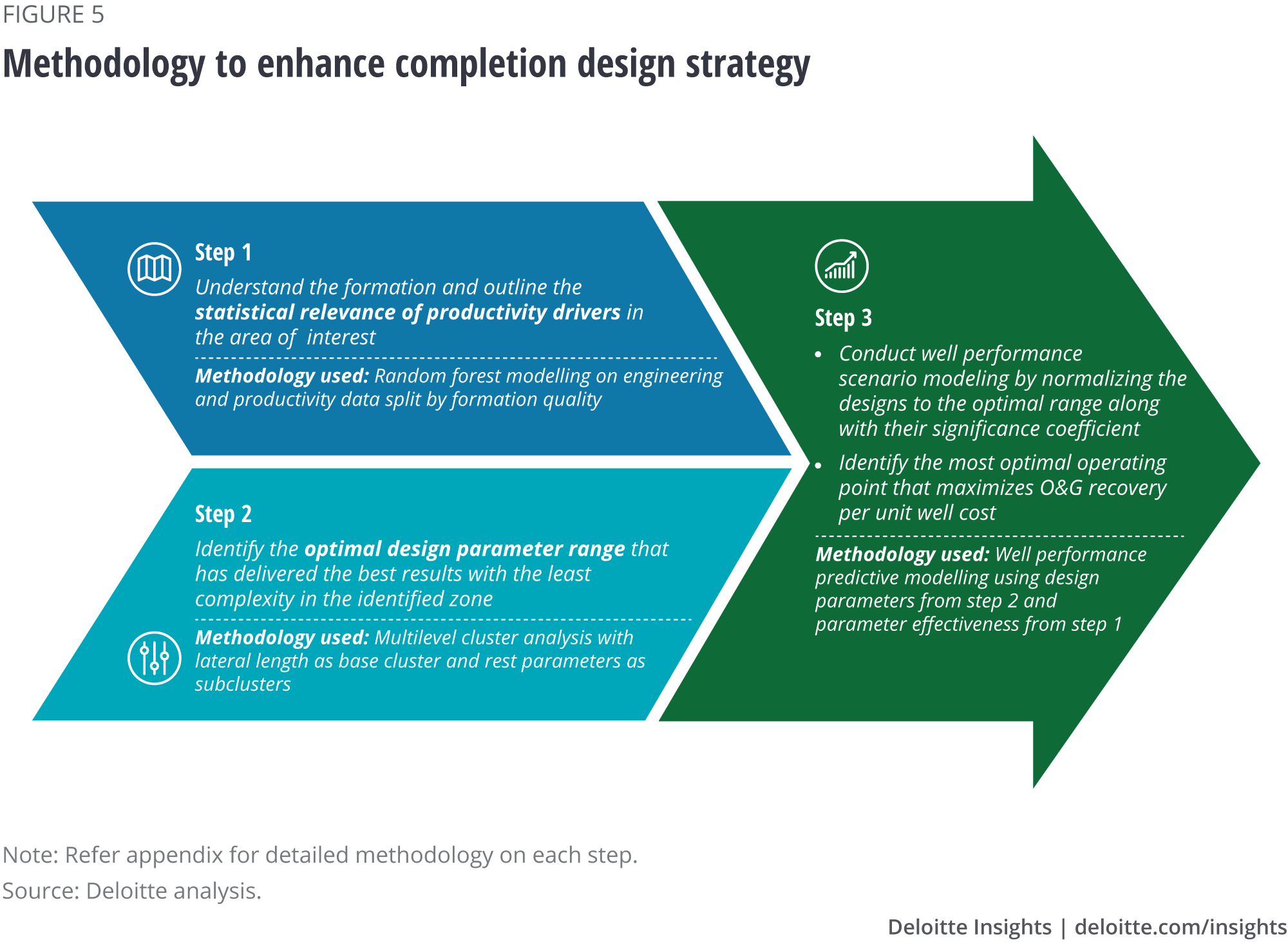
Step 1: Understand the rock’s response to completion designs
It is clear that productivity gains realized in the Permian basin are because of notable contributions by enhanced and more intense completion designs. However, “what” specific parameters impact productivity in “which” formations and “how” strong these relations are is something that is far less understood. Operators usually measure the efficacy of a design tweak through production, but clear isolation of variables is critical to ascertain the future performance of a design.15 The magnitude of gains in the past somehow subdued these questions but a microlevel understanding about what exactly is happening beneath the earth is important for enabling future productivity gains.
To answer this, we modeled various completion parameters (perforated interval, proppant loading, fluid loading, proppant type, and treatment type) with well productivity and outlined the statistical relevance of these variables (refer to the appendix for methodology). Although a consistently high significance of perforated interval, proppant loading, and fluid loading (see figure 6) is quite obvious, their changing prominence among zones highlights the importance of optimizing the formation-engineering equation rather than focusing solely on design enhancement.
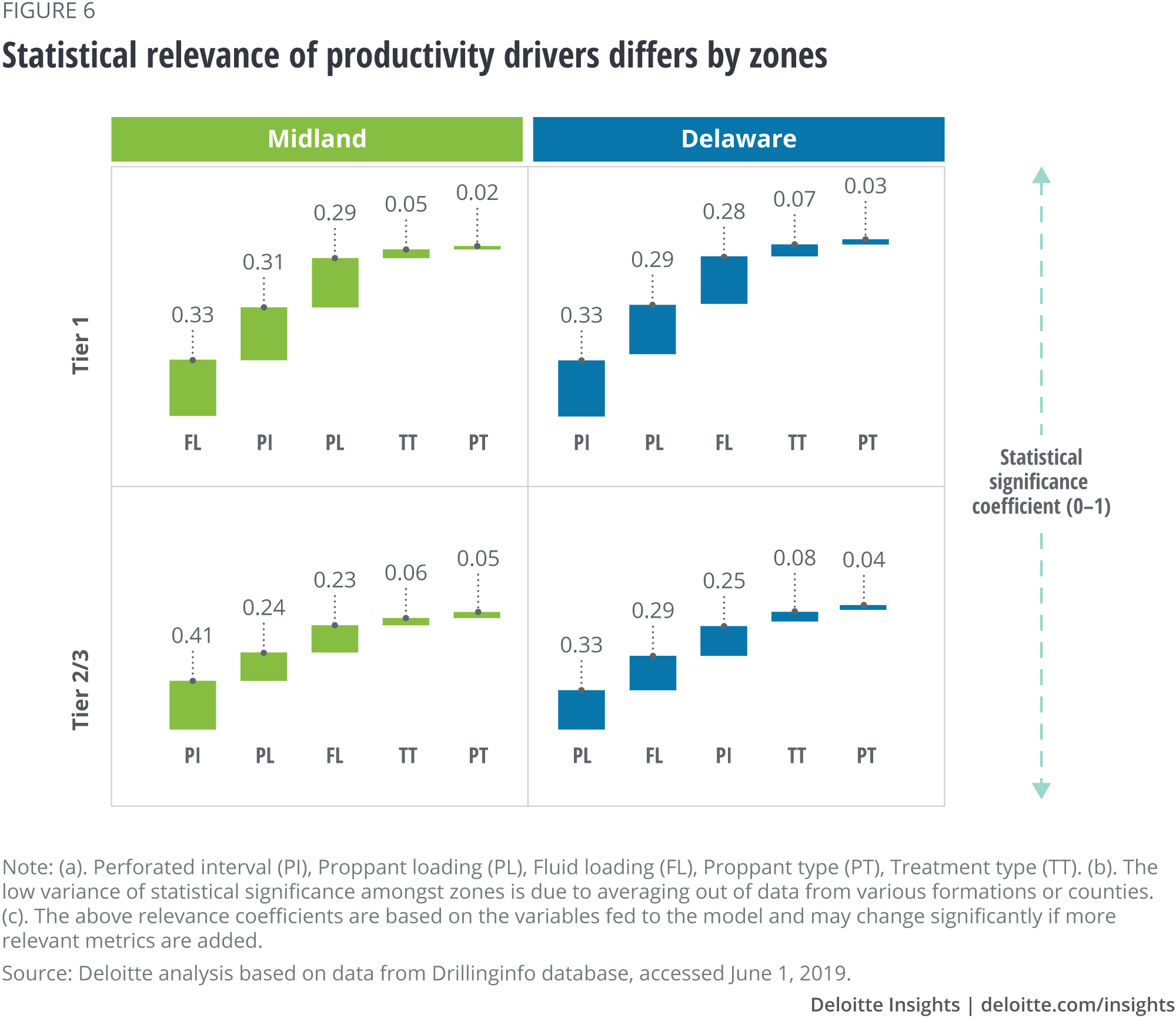
Perforated interval is a key productivity driver in Tier 2/3 formation quality zone of Midland and Tier 1 zone of Delaware, while fluid loading is most influential in Tier 1 zone of Midland, and proppant loading is key in Tier 2/3 formation of Delaware. The coefficients of top influencing parameters are quite close at an aggregate zone level, but there are notable variations when these aspects are analyzed at a formation or county level. These ranks and coefficients could directionally guide design teams about the criticality of a variable for their area of interest.
For instance, it is evident that proppant type is the least significant variable among the ones analyzed and hence it won’t impact productivity in any zone. Most operators realized this in the past few years and reduced their usage of ceramic proppants, while some continued to experiment with resin-coated proppants instead of sand to realize superior performance. However, despite the low statistical importance of treatment type in Midland, 36 percent of the recent wells completed used superior well fluids and that too with small mesh size proppants that are easily compatible with slickwater.16
Step 2: Identify optimum completion design for each rock
After a thorough understanding of the rock’s response to completion variables, the next step involves narrowing down the wide range of parameter values and identifying optimal operating point in each zone. We leveraged a multilayered cluster modeling approach to achieve this, where perforated interval acted as the base cluster, while the remaining parameters were subclusters under each (refer appendix for detailed methodology). Further, knowing that highly productive wells exist on both ends of the design spectrum, a good well design was defined as the one that delivers a solid productivity profile with the least design complexity for a sizeable number of wells.
This exercise revealed that 56 percent of the high-performing wells spud since January 2016 in Tier 1 formations of Delaware were developed with a perforated interval in the range of 4,000–6,000 feet.17 Further, these wells leveraged small-sized sand proppants with a pumping rate of 1,860–2,790 lbs/ft and preferably a slickwater fluid pumped at 42–56 bbl/ft.18 Interestingly, 70 percent of these performing wells in the 4,000–6,000 feet perforated interval category were drilled by large independents and some integrated oil companies that have long continuous acreages in those areas, but they still went for shorter laterals to maximize productivity and hence the value.
On the other hand, the optimal perforated interval range for Midland was 7,000–9,000 feet, with much lower intensity as compared to Delaware.19 Again, formation analysis is quite important in this part to understand the divergences—thicker Midland formations make longer laterals more effective, while lower bulk density and slightly more shale content in Delaware warrant the need for more intense fluid and proppant loading.
It is worth noting that figure 7 reflects the combination of parameters that delivered high productivity with minimal complexity and not the only combination that led to superior performance. Moreover, these ranges can and should be narrowed down further for each county or landing zone by feeding proprietary completion data and triangulating it with in-depth rock understanding.
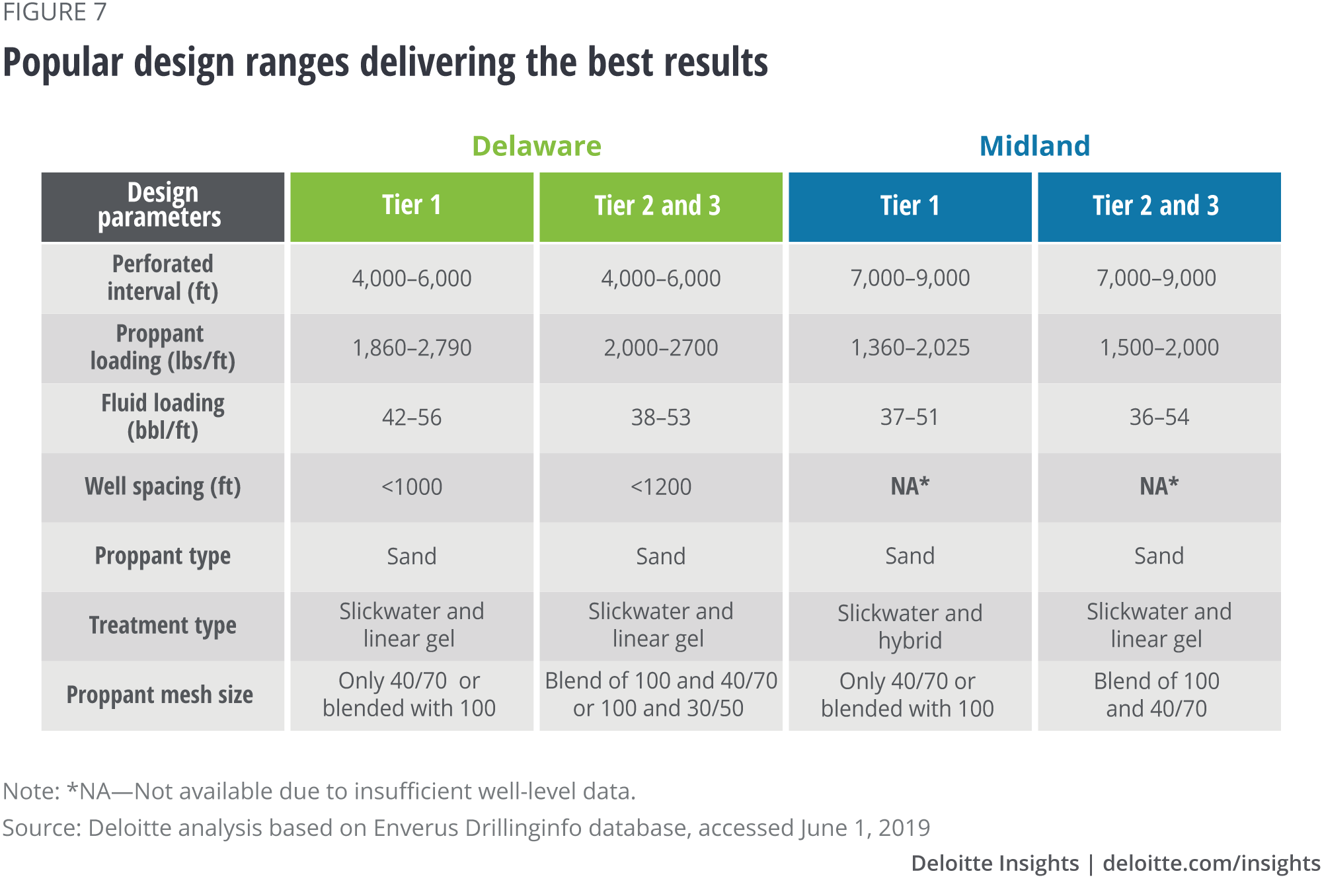
Benchmarking designs of operators in the Permian basin
Benchmarking the designs of wells drilled in the past four years against their respective “popular design range” shows that only 33 percent of the total wells are in the desired range and 74 percent of those wells had high productivity (>1,000 boed). Interestingly, 60 percent of these in-range wells fall in Delaware, which is relatively less mature as compared to the adjacent Midland basin. Further, 24 percent of the total wells were under-engineered, which means they might have lost some opportunity in terms of recovery—70 percent of these wells were relatively low on productivity (<1,000 boed).20
Lastly, 43 percent of total wells seem to be over-engineered, which indicates a possibility they could have saved some cost and still realized a competitive well performance (see figure 8). Seventy percent of these over-engineered wells fall in Tier 1 zone of Delaware and Midland, as companies were hopeful of extracting more from these formations by intensifying designs.21
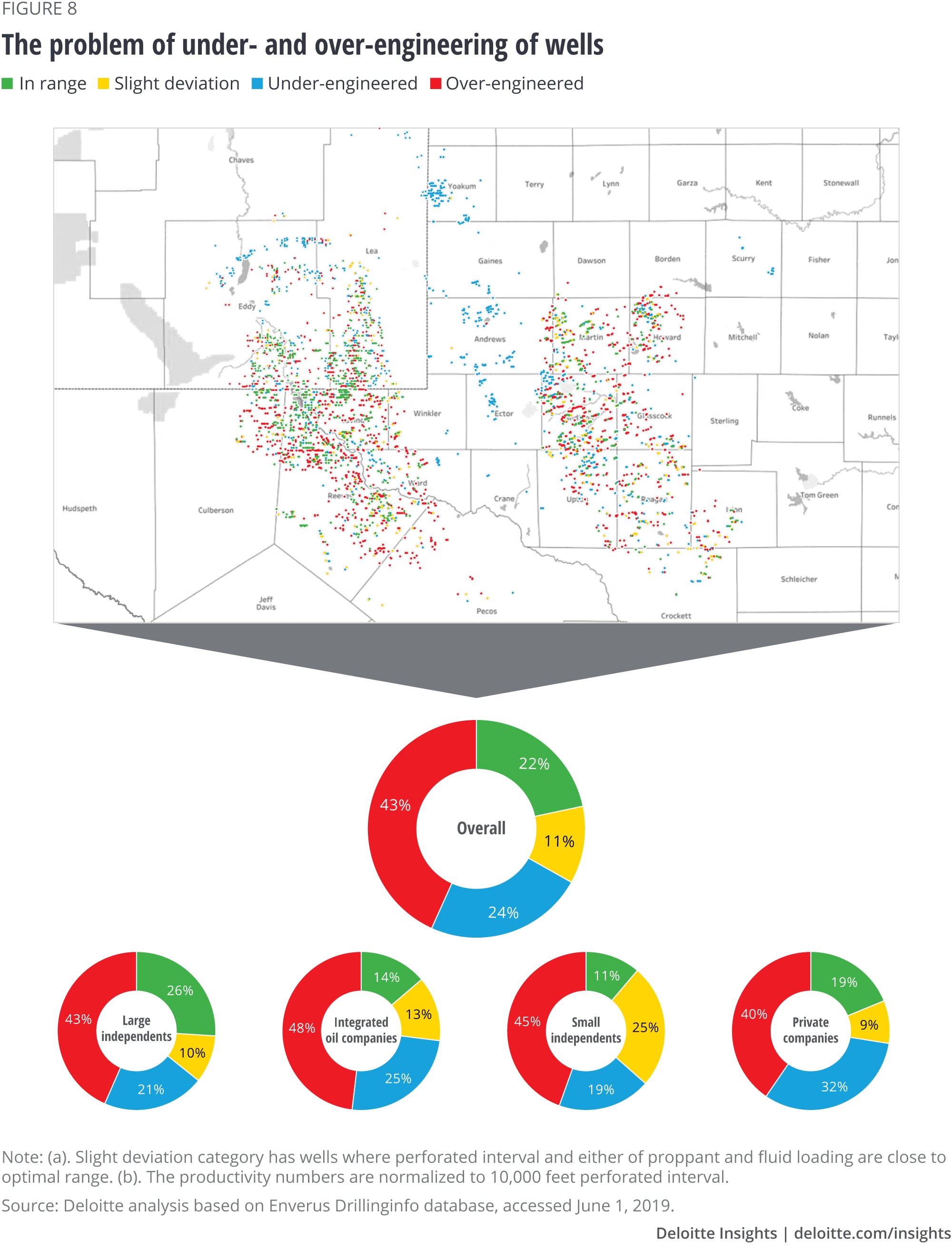
The landscape seems quite similar for almost all the company groups with some exceptions. Large independents had the highest share of wells falling in exact identified ranges, followed by private companies. One of the leading independent E&P, for example, has 50 percent of its wells in the optimal range and all of them drilled in the north of Loving and southern Lea counties. Limited by capital availability, a high share of under-engineered wells for private players reflects their cautious approach, while a high proportion of over-engineered wells for supermajors reflects their intense experimentation strategy.22
Step 3: Make every dollar count
The final phase involves bringing the outputs from earlier analysis—that is, optimum ranges of completion parameters and their statistical significance to conduct scenario modeling that can predict well performance by tweaking designs. The ultimate objective of this exercise is not to maximize productivity but to find the best operating point where estimated ultimate recovery (EUR) per unit well cost is maximum (refer to the appendix for methodology). This is of the utmost importance in today’s market landscape where investors are continuously questioning the ability of shale players to balance growth and returns. Marathon Oil’s CEO, Lee Tillman, also highlighted this when he mentioned, “Today our dilemma is that as a sector, we have destroyed a lot of trust in the investment community over the last decade.”23
The results of these scenario models on 5,300 under- and over-engineered wells drilled since January 2016 also affirm investors’ concern as it appears that there was scope—or a missed opportunity—to improve the capital efficiency (EUR per unit well cost) in the Permian by 23 percent (see figure 9).24 The chances to improve were a lot more in the over-engineered wells where the fall in production due to design simplification was more than offset by significant cost savings. For example, in 1,480 such wells in Delaware, a shift to the optimal design range could have lowered the well cost by an average of 39 percent with only a 16 percent hit on production.25 A point worth noting here is that some players with massive above-surface infrastructure might still do well with over-engineered wells as it brings down other cost elements, but for the rest, optimizing this equation at a well level might work better.

Most of the design normalizations seem to have improved the capital efficiency of wells, except the under-engineered wells in Midland where the designs appear to be already optimized on the economic front. With increased completion intensity, these wells could have realized higher production but at the same level of returns. Fifty-two percent of these wells are operated by small independents and private companies in Martin, Howard, and Midland counties and it clearly reflects their focus on maximizing returns over volumes.26
Summing up, exceptional well performances in many areas attest the notable strides taken by the industry to enhance its understanding of shale plays. However, flattening gains now call for companies to embrace a new future where they combine their technical know-how with analytical capabilities to further enhance their engineering strategy. Having the right blend of these would not only allow companies to maximize productivity but could also enable optimum utilization of every dollar spent on developing a well.
Still young and raring to go
While acknowledging the fact that there are some well-performance issues in the Permian, it is apparent that the learning curve of the basin’s unconventional oil and gas is still young and its prospects of surprising the industry yet again are quite bright. This is where operators could leverage the short-cycled and rapid-fire nature of shales and accelerate their learning for maximum gains. As they move ahead in their growth journey, companies should keep in mind the following considerations:
- Funnel the design strategy—Narrow down design parameters in each formation/zone to identify operating points that are not only productive but also ensure the highest possible ROI.
- Replace selectivity with entirety—Move away from selective reporting of parameters and present a comprehensive picture and report out learning progressions to build investor confidence.
- Refresh the portfolio strategy rulebook—Break away from a mindset of optimizing portfolios based on just the quality of formation and add new elements such as experience in the field, response to various designs, and infrastructure availability.
- Understand the “how” and “why”—Invest in advanced technologies such as microseismic monitoring and tracer analytics to understand how and why the reservoir is behaving in a certain fashion and then augment the development approach.
- Avoid herd instincts—Appreciate the value learning from peers while recognizing shale’s erratic behavior. Although a strategy (for example, Gen X completions) might look appealing, it may not make economic sense for all and could hurt project returns.
Appendix
Key assumptions and considerations
- The analysis presented here is an analytical perspective to shale development and hence cannot be a replacement to sophisticated technical models.
- The formation quality zones are classified using available geological data points (gamma ray, neutron porosity, formation thickness, deep resistivity, bulk density) and these should not be directly compared with other technical formation quality maps.
- The statistical relevance of various completion variables is based on the number of variables fed to the model. These numbers will likely change once more data or more variables are used to build models.
- The defined optimal operating points are directional ranges aimed to highlight the divergence by each zone. These could notably change once analyzed at formation or county level and hence should not be directly leveraged for technical analysis.
- The optimal operating point reflects designs with moderate intensity and high productivity. Hence, it should not be assumed that designs that are more intense are always less productive.
- The economic well models are based on recent cost trends in each sub-basin and actual numbers may vary based on company-specific cost efficiencies.
Methodology to define the boundary of zones by formation quality
At first, spatial mapping of all the wells in a basin was done using the surface latitude and longitude data (see figure 10). Further, low-formation quality wells were filtered out using the formation quality index developed in Deciphering the performance puzzle in shales (wells with a formation quality score of less than 0.54 and 0.6 were filtered out for Delaware and Midland, respectively).
We then manually defined the boundary of the zone that comprises most of the high-quality wells and generated the latitude-longitude readings of the newly created boundary. This newly created geographic zone comprising high-quality wells was termed as Tier 1 formation while the rest were defined as Tier 2/3 zones. Lastly, graphical overlaying with existing formation quality maps by various operators was done to fine-tune the formation quality zone boundaries.
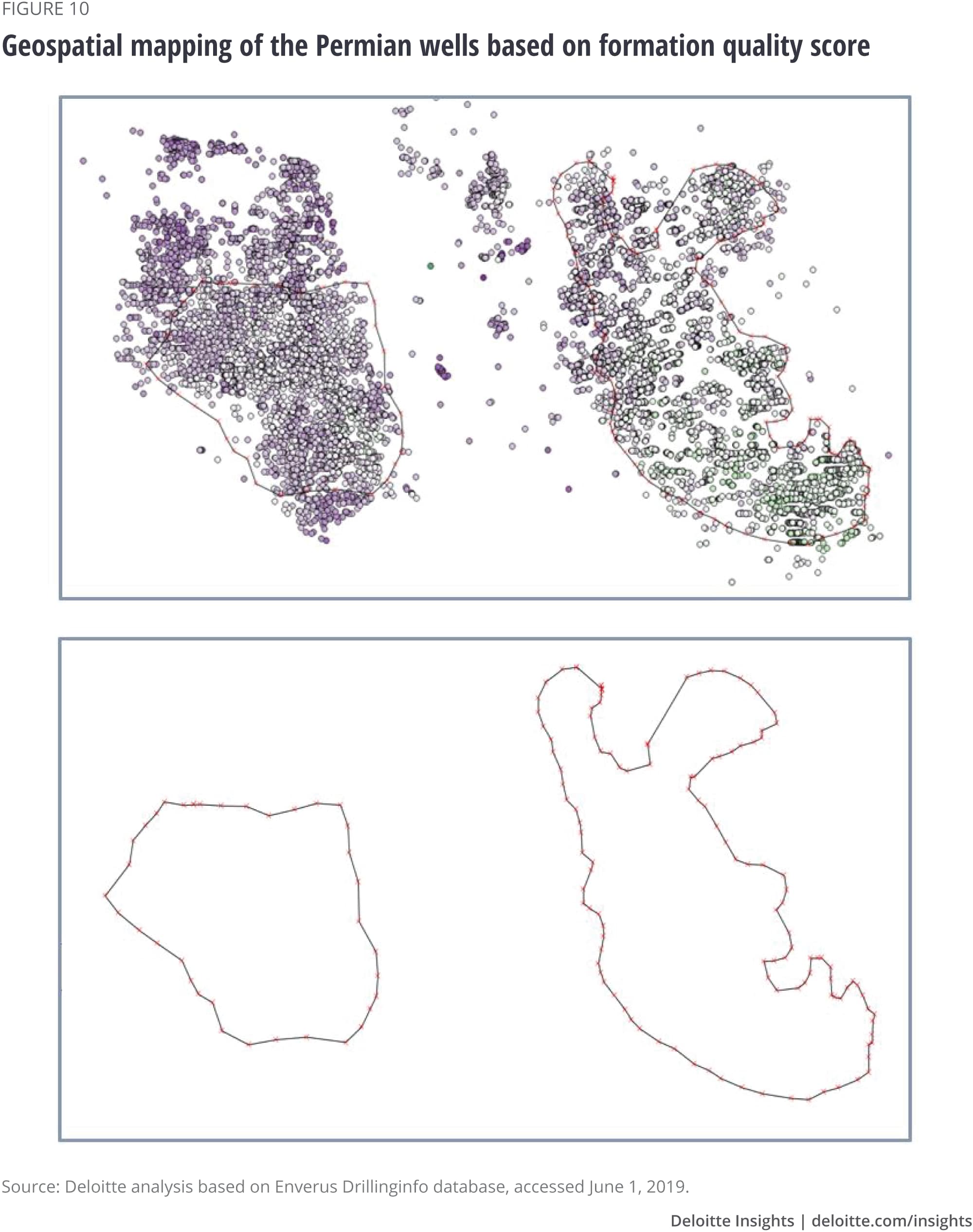
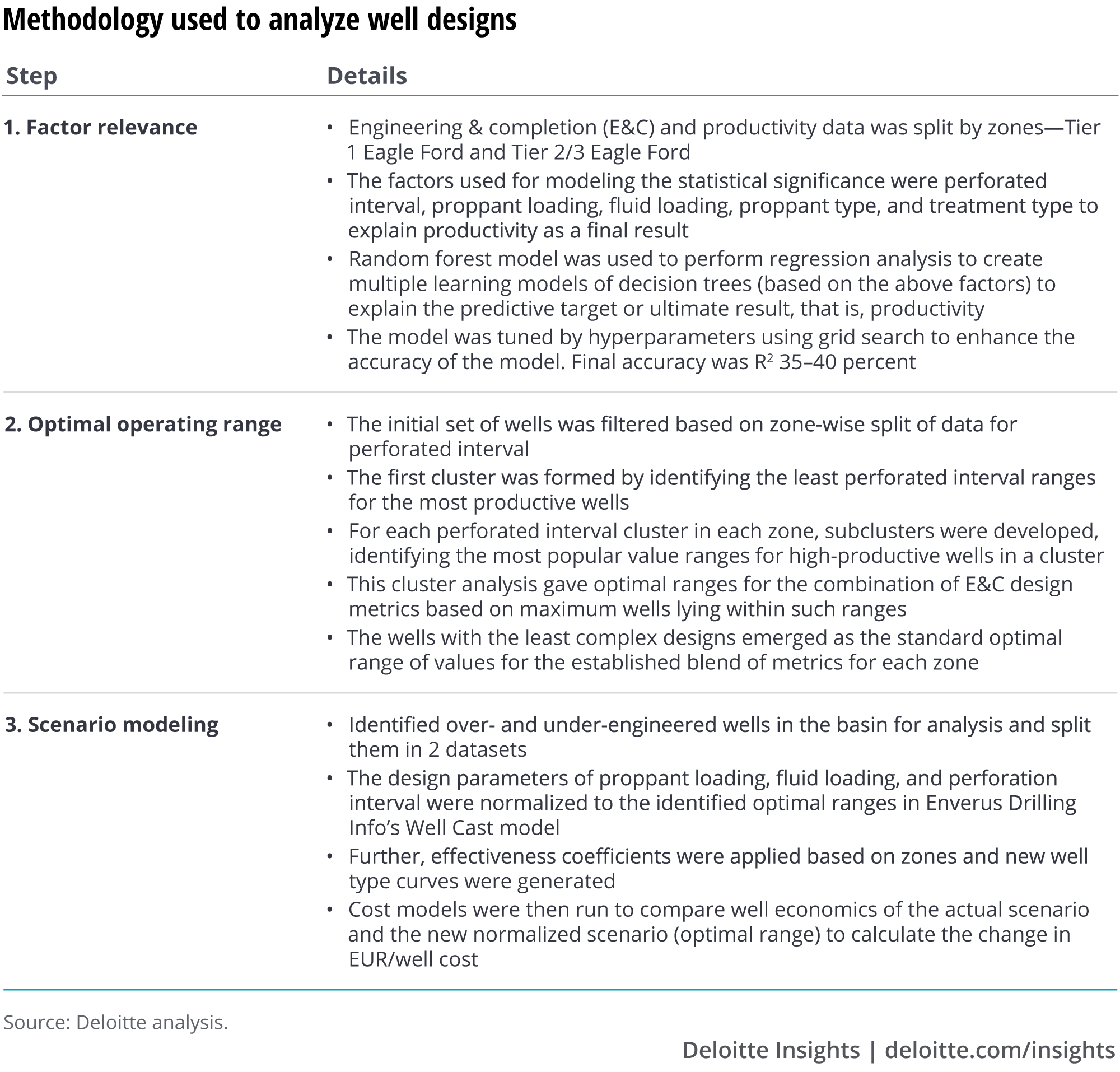
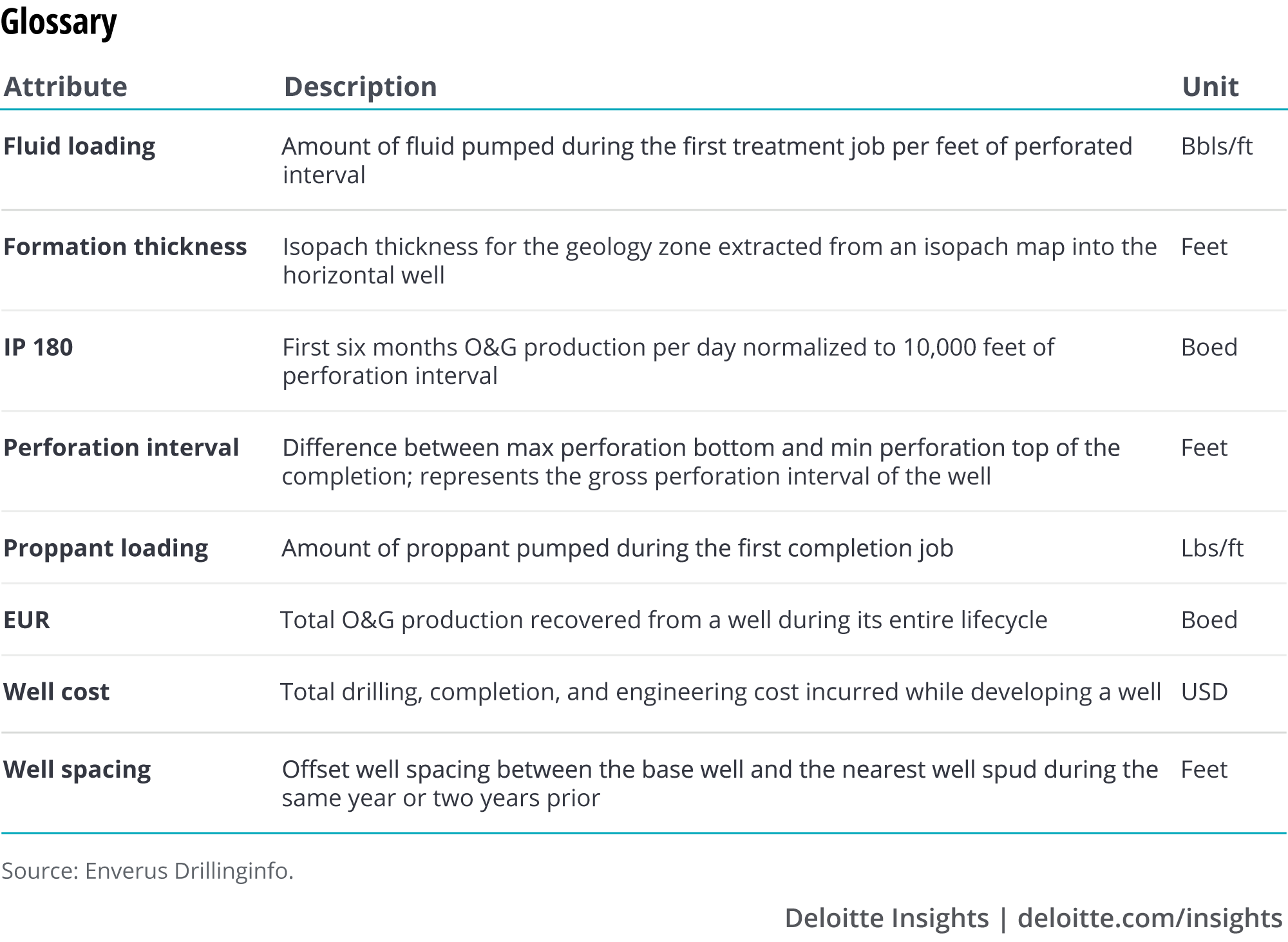
© 2021. See Terms of Use for more information.
More in Oil, Gas & Chemicals
-
How the shale revolution is reshaping the US oil and gas labor landscape Article6 years ago
-
Oil’s well?: Divergence and imbalance in the oil and gas ecosystem Article5 years ago
-
One Downstream Article5 years ago
-
Energy management: Paused by pandemic, but poised to prevail Article4 years ago
-
Refining & marketing: Eyeing new horizons Article5 years ago












